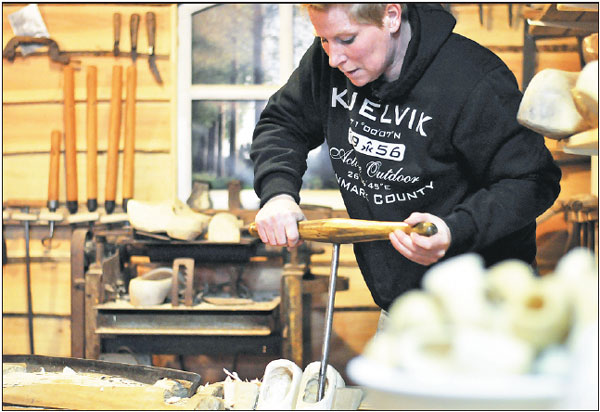Dutch clog-makers hoping to put a stamp on the future
AARLE-RIXTEL, Netherlands - Just decades ago there were thousands. Now only about 30 Dutch clog-makers remain, fighting to save a dying craft with the wooden shoes more often found today as fridge-magnets rather than footwear.
Expertly wielding a long metal spoon-like tool, Nicole van Aarle rhythmically hewed away at a piece of willow, the shavings falling at her feet, the walls of her workshop in the southern Dutch town of Aarle-Rixtel adorned with clogs of all shapes and sizes.
"I work when I can. In the evenings, or after dropping the kids off at school, at weekends. But I can't make a living just from making clogs," said the former soldier, who is proud of being a fifth-generation clog-maker.
At 40, she is one of the country's youngest clog-makers and represents the future of a trade in which most craftsmen are already reaching retirement age.
It's a "very worrying situation," said Pieter van Rooij, from the Dutch Heritage Center.
"Preserving this craft is long overdue, to ensure that it is handed down to future generations. Otherwise we will lose the know-how of how to make this Dutch icon."
Even though clogs have been made for centuries across many countries such as in France and Britain, they have become as synonymous with this lowlands country of 17 million people as tulips and windmills.
Up until World War II, clogs were the footwear of choice for most Dutch people.
Made from a single piece of wood, they are "warm, dry and not very expensive," said Jack van der Voort, president of the Dutch Clog Monument association.
"And you can adapt the shape of the shoe to your job, to the ground on which you work, to the region."
Dying art
But the tradition "is almost dead," he said, calculating that only about 40 clog-makers remain in Europe, of which 30 live in The Netherlands.
"It's like chips in Belgium or German sausage, we have to preserve it," said Van Aarle.
"Of course everyone wants to eat chips. But clogs are difficult to walk in, so it's more complicated."
Since the end of the war, the Dutch have increasingly donned rubber or leather footwear and clogs have become a sign of a rural past.
Van der Voort and Van Aarle have started to organize markets, festivals and even a national clog-making championship in their passion to keep their handicraft alive.
"The interest is there. People are beginning to become interested in their traditions again," said Van der Voort.
And new uses are coming to the fore.
"Young people going to music festivals are sometimes wearing clogs. They protect them from the mud, they're easy to take off outside a tent and no one steps on your toes," said Van Aarle.
|
Shoemaker and former soldier Nicole van Aarle bores a hole out of a wooden shoe in Aarle-Rixtel, in the southern Netherlands.Maude Brulard / Agence Francepresse |



















